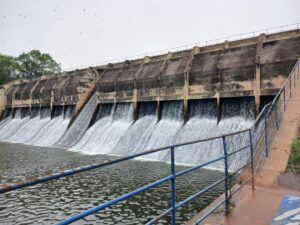Encroachers take over Barekese Water Treatment Plant
 The Ghana Water Company Limited (GWCL) says the continued encroachment around the Barekese Dam by residents poses a serious threat that can lead to potential water crisis in the Greater Kumasi Area.
The Ghana Water Company Limited (GWCL) says the continued encroachment around the Barekese Dam by residents poses a serious threat that can lead to potential water crisis in the Greater Kumasi Area.
It says illegal activities in the catchment area of the Barekese Treatment Plant is a major concern, which needs immediate attention.
The company said the Barekese catchment area had experienced an 80 per cent reduction in forest cover, leading to a 53 per cent increase in siltation, which had significantly reduced the reservoir storage capacity from 64.6 Mm3 to 21.4 Mm3.
It blamed these on the extensive farming activities around the area.
To address the situation, the Company convened a stakeholder forum, in which chiefs, the Public Utilities Regulatory Commission (PURC), the Forestry Commission, and students participated to find a sustainable solution to the challenge.
It formed part of activities marking this year’s World Water Day at Barekese in the Ashanti Region.
The event was held on the theme: “Leveraging Water for Peace: Promoting Utilization of Water for Peace.”
Dr Hanson Mensah-Akutteh, the Regional Chief Manager of GWCL, Ashanti Production, said due to the encroachment, the reservoir had been exposed to evaporation, leading to disruption in water distribution to 80 per cent of residents in Kumasi and its environs.
The Regional Chief Manager emphasized that the extensive farmlands had transformed the area into bare lands, leading to significant siltation after every downpour.
The siltation had covered a large part of the dam, leaving only a small section, which might significantly affect the effective distribution of water to the Greater Kumasi area in the coming days.
“The forest cover that is supposed to protect the catchment area has been reduced, in other words, all the trees are gone, and the cover has turned into bare land where farming activities are now ongoing,” he said.
The continuous reduction of water volume in the dam due to the activities of farmers and other encroachers were affecting water supply.
“Even though we have a reservoir with a capacity of 64 million metre cube, almost half of that volume is currently occupied by silt,” Mr Mensah-Akutteh said.
“If this continues, a time will come when we will have little volume of water to serve the people of Kumasi, which if it’s not available, it means we cannot produce and nobody will get water.”
Already, some areas within Greater Kumasi have started experiencing shortage of water supply.
Nana Kusi Oboadum, a Sub-Chief at Barekese, attributed the situation to the District Assembly and the Forestry Commission granting permission for tree cutting and farming activities around the area.
He said: “The Chiefs cannot sell lands that are within buffer zones. The District Assembly should enforce the law on encroaching buffer zones and make sure such people are dealt with.”
The company and stakeholders stressed the need for collective efforts to address encroachment and illegal mining activities to safeguard water supply in the region.
Source: GNA
